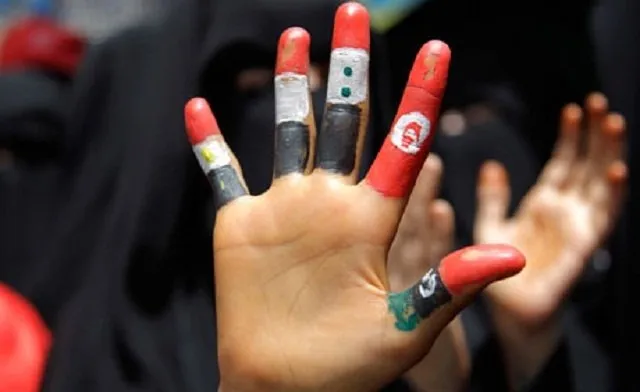
We know social media is effective in recruitment...
FOR GOOD...
In 2011, Nahed Eltantawy and Julie B. Weist argued that "social media played an instrumental role in the success of the anti-government protests that led to the resignation of the country’s dictatorial leader" in their study on the use of social media in the 2011 Egyptian Revolution. They [International Journal of Communication V. 5, 2011: ”Social Media in the Egyptian Revolution: Reconsidering Resource Mobilization Theory”]
Likewise, the Iraqi Antiwar Movement--through the use of social media and the internet--was able to unite nearly 10 million activists across the globe to participate in anti-war demonstrations in hundreds of cities in 2003, through the use of social media avenues like Facebook, Twitter, and Flikr.
Other similar anti-war movements took place all over the Middle East in similar fashion, such as the Facebook videos and tweets that lead to Arab Spring—the overthrow of Tunisia’s government in 2011, in the study above.

img from english.alarabiya.net
Alarmingly, most of these campaigns are largely unfunded or underfunded. Many of them are “grassroots” videos and messages that simply go viral, and often the leaders of the movements are not the authors of the videos.
...AND FOR EVIL
ISIS has likewise been increasingly successful at using social media to penetrate and recruit youth and young adults for its organization. Dr. John Horgan, a forensic psychologist and expert of terrorist behavior at Georgia State University in Atlanta, said “Recruitment is an intensely personal experience” because they “recognize the tailor-made efforts with teenagers. They’ll use North American young 20-somethings to target teenagers, [or] they’ll use females to target female teenagers, [or] they’ll use English speakers to target English speakers.”
ISIS recruiters prey on the vulnerabilities of youth, especially in places of unrest in the Middle East. Many of these kids are angry, confused, lonely, scared. They want to make a difference. They want to belong. They are developmentally “invincible” and crave a sense of justice and control in their world. They want the world not to feel so large and vacuous.
Hell, what teenager DOESN’T feel these things? ISIS swoops in and gives them purpose, tricking them into thinking they are joining forces with something good and important—not unlike the tactics Hitler used in charming his NAZI recruits.

The Perfect Child (img from mrallsophistory.com)
WE ALSO KNOW MONEY IS EFFECTIVE IN RECRUITMENT
For youth whose families are suffering from hunger and homelessness, or poverty in any form, an added monetary incentive proves almost irresistible in most cases. With the sickeningly abundant resources available to ISIS, recruitment is a piece of cake, comparatively speaking.
WE KNOW WHAT THESE YOUTH NEED:
- A feeling of belonging
- A sense of Justice and fairness
- Money
- Security
- A sense of purpose
Well, guess what? ISIS handles all of these, and a promise of eternal reward on top of it all. Which is why NATO and U.S. attempts at diversion have failed. We simply cannot compete…..or can we?
OBAMA’S APPROACH FAILED BECAUSE…
Obama's approach thus far has been to educate, inform, and highlight the "facts" and "atrocities" of ISIS, so as to discourage youth from joining by appealing to their logic and conscience. His most famous debacle was the U.S. Department of State viral video called “Welcome to ISIS Land.” I am not going to post the video. It is graphic.
Don’t get me wrong. It was a powerful and educational video. It went viral. People got the message. And it was an irritant to ISIS. But it fell flat. ISIS numbers continued to rise, and exponentially.
The video and other campaigns similar to it worked maybe for a sparse few, temporarily. But teens are teens. Their prefrontal cortex is not fully developed at least until the age of 18.

img from connersclinic.com
This video appeals to the emotions of fear and disgust. True. But also it appeals to morality and logic, and gives no reward. We cannot possibly appeal to an audience by means of logic and morality when their executive functioning has not even developed yet!
ISIS knows the best way to appeal to tweens and teens is to ignite (or assuage) their emotions, gratify their hormones, calm their sense of helplessness, enlarge their tiny view of the world, fuel their desire to be a part of something bigger than themselves, feed their interpretations of what’s “cool”, and fill their wallets, and their wardrobes.
Teenagers usually have the feeling of "I don’t fit. I don’t belong here. I want something bigger. I want to do something better with my life," Dr. Horgan explains. “Those are the types of things recruiters latch onto and exploit, and they’re very good at it. It’s a fantasy, ultimately, that recruiters will use to keep the conversation going on.”
As it turns out, STEEMIT has the capacity to combat this. Here's how...
MY PROPOSAL:
We (and by “we” I mean Dan and Ned) could come up with a social media site built on a blockchain cryptocurrency platform—sort of like the one we have here, go figure. It could target and reward teens by paying them for productive content, kind of like here.
The site would be in a language common to the region and would have a cryptocurrency pegged to a familiar currency of the region, even if that currency was not exceptionally stable. Or it could be pegged to the US dollar—that might be alluring.
“How To” and "FAQ'S" pages explaining the basics of how to get started would be necessary because the site would be primarily designed to target youth who may lack the education, computer literacy, and patience sufficient to navigate a new system.
Anonymity would be a given, due to the risk of harm many individuals might face from censorship laws in their regions.

img from steemit.com
Regulators could down vote material that started revolt, encouraged terrorism or violence, or degraded in any way. This would need to be a constant mission that would likely not be sustainable on precedent alone. Goals for the platform would need to be expressed clearly on the front page. It would need to be regulated effectively. Witnesses and platform regulators would speak natively, and they would reward productive content that solved geopolitical issues, shared original thought, entertained tastefully, encouraged healthy debate, and promoted good behavior.
Not unlike a think tank, which is a perfectly viable reward model.
The reward system might be designed to make smaller, but more frequent payouts, so as to capture the attention of more users, more quickly, and also to avoid drawing any unnecessary attention to individuals who may live in areas where sudden and/or surplus income might cause government interrogation or pilfering.
This platform, if crafted carefully, would effectively deter many young people from joining ISIS. Why? Because it would solve most, if not all, of the needs ISIS is meeting in these youth:
- A feeling of belonging by having a community to interact with in positive ways
- A sense of Justice and fairness through expression
- Getting PAID for that expression (as opposed to being tortured, imprisoned, or outcast, which would be the case for many of these kids and their families if they were to speak openly)
- Security gained from earning money
- A sense of purpose by generating original thought and coming up with solutions
MY ONLY PROBLEM:
It obviously has a bit of a “group think” feel to it, to be fair. And who’s to say Steemit isn’t that very thing? Money has a Pavlovian affect on human nature. But this does not have to be a bad thing. Why not use it as part of a series of important motivators for our youth in the Middle East and all over the world, and develop an engine they can belong to, earn from, and contribute to, so they will not be as susceptible to the baits of ISIS.